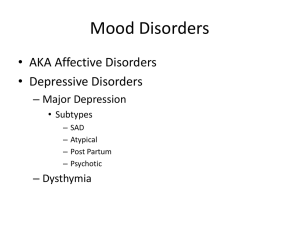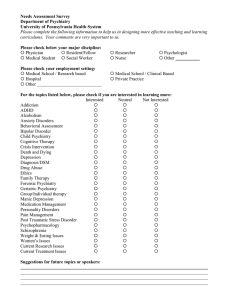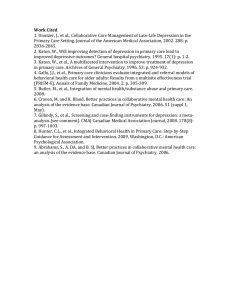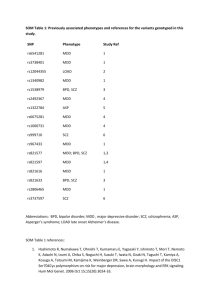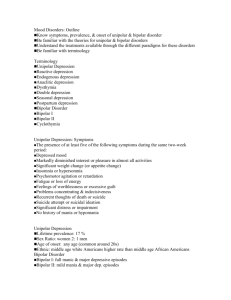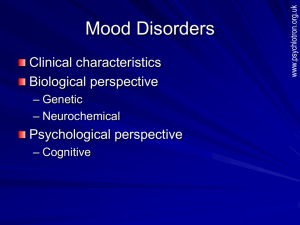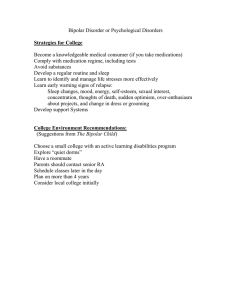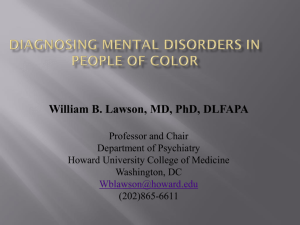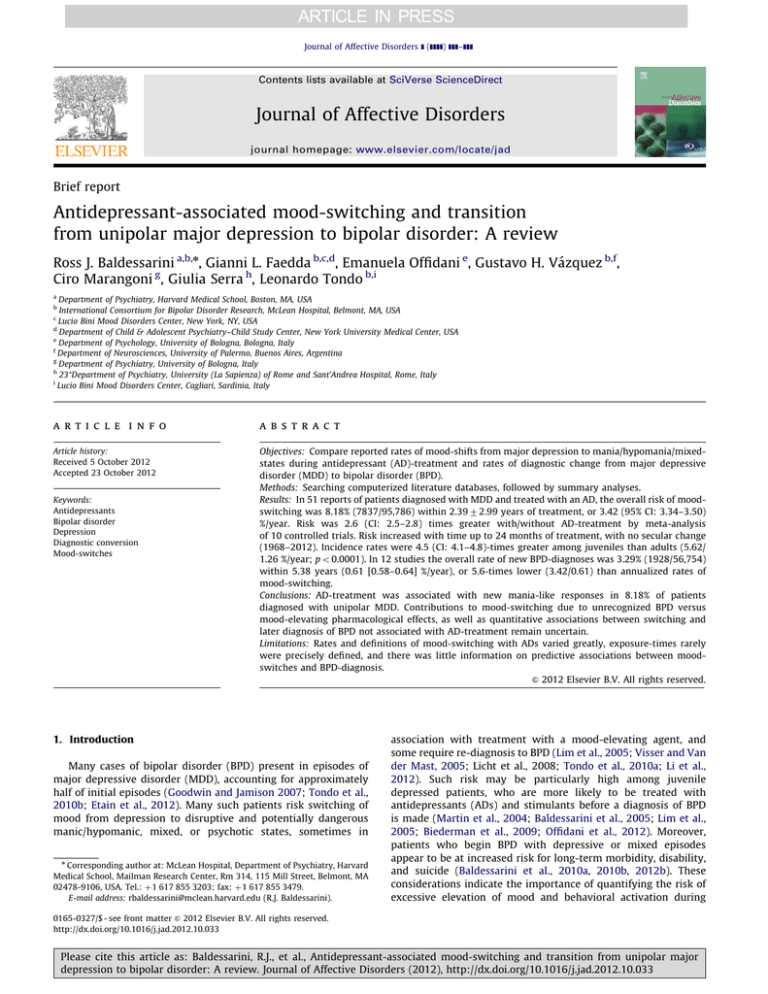
Journal of Affective Disorders ] (]]]]) ]]]–]]]
Contents lists available at SciVerse ScienceDirect
Journal of Affective Disorders
journal homepage: www.elsevier.com/locate/jad
Brief report
Antidepressant-associated mood-switching and transition
from unipolar major depression to bipolar disorder: A review
Ross J. Baldessarini a,b,n, Gianni L. Faedda b,c,d, Emanuela Offidani e, Gustavo H. Vázquez b,f,
Ciro Marangoni g, Giulia Serra h, Leonardo Tondo b,i
a
Department of Psychiatry, Harvard Medical School, Boston, MA, USA
International Consortium for Bipolar Disorder Research, McLean Hospital, Belmont, MA, USA
Lucio Bini Mood Disorders Center, New York, NY, USA
d
Department of Child & Adolescent Psychiatry–Child Study Center, New York University Medical Center, USA
e
Department of Psychology, University of Bologna, Bologna, Italy
f
Department of Neurosciences, University of Palermo, Buenos Aires, Argentina
g
Department of Psychiatry, University of Bologna, Italy
h
23*Department of Psychiatry, University (La Sapienza) of Rome and Sant’Andrea Hospital, Rome, Italy
i
Lucio Bini Mood Disorders Center, Cagliari, Sardinia, Italy
b
c
a r t i c l e i n f o
abstract
Article history:
Received 5 October 2012
Accepted 23 October 2012
Objectives: Compare reported rates of mood-shifts from major depression to mania/hypomania/mixedstates during antidepressant (AD)-treatment and rates of diagnostic change from major depressive
disorder (MDD) to bipolar disorder (BPD).
Methods: Searching computerized literature databases, followed by summary analyses.
Results: In 51 reports of patients diagnosed with MDD and treated with an AD, the overall risk of moodswitching was 8.18% (7837/95,786) within 2.39 72.99 years of treatment, or 3.42 (95% CI: 3.34–3.50)
%/year. Risk was 2.6 (CI: 2.5–2.8) times greater with/without AD-treatment by meta-analysis
of 10 controlled trials. Risk increased with time up to 24 months of treatment, with no secular change
(1968–2012). Incidence rates were 4.5 (CI: 4.1–4.8)-times greater among juveniles than adults (5.62/
1.26 %/year; po 0.0001). In 12 studies the overall rate of new BPD-diagnoses was 3.29% (1928/56,754)
within 5.38 years (0.61 [0.58–0.64] %/year), or 5.6-times lower (3.42/0.61) than annualized rates of
mood-switching.
Conclusions: AD-treatment was associated with new mania-like responses in 8.18% of patients
diagnosed with unipolar MDD. Contributions to mood-switching due to unrecognized BPD versus
mood-elevating pharmacological effects, as well as quantitative associations between switching and
later diagnosis of BPD not associated with AD-treatment remain uncertain.
Limitations: Rates and definitions of mood-switching with ADs varied greatly, exposure-times rarely
were precisely defined, and there was little information on predictive associations between moodswitches and BPD-diagnosis.
& 2012 Elsevier B.V. All rights reserved.
Keywords:
Antidepressants
Bipolar disorder
Depression
Diagnostic conversion
Mood-switches
1. Introduction
Many cases of bipolar disorder (BPD) present in episodes of
major depressive disorder (MDD), accounting for approximately
half of initial episodes (Goodwin and Jamison 2007; Tondo et al.,
2010b; Etain et al., 2012). Many such patients risk switching of
mood from depression to disruptive and potentially dangerous
manic/hypomanic, mixed, or psychotic states, sometimes in
n
Corresponding author at: McLean Hospital, Department of Psychiatry, Harvard
Medical School, Mailman Research Center, Rm 314, 115 Mill Street, Belmont, MA
02478-9106, USA. Tel.: þ1 617 855 3203; fax: þ1 617 855 3479.
E-mail address: rbaldessarini@mclean.harvard.edu (R.J. Baldessarini).
association with treatment with a mood-elevating agent, and
some require re-diagnosis to BPD (Lim et al., 2005; Visser and Van
der Mast, 2005; Licht et al., 2008; Tondo et al., 2010a; Li et al.,
2012). Such risk may be particularly high among juvenile
depressed patients, who are more likely to be treated with
antidepressants (ADs) and stimulants before a diagnosis of BPD
is made (Martin et al., 2004; Baldessarini et al., 2005; Lim et al.,
2005; Biederman et al., 2009; Offidani et al., 2012). Moreover,
patients who begin BPD with depressive or mixed episodes
appear to be at increased risk for long-term morbidity, disability,
and suicide (Baldessarini et al., 2010a, 2010b, 2012b). These
considerations indicate the importance of quantifying the risk of
excessive elevation of mood and behavioral activation during
0165-0327/$ - see front matter & 2012 Elsevier B.V. All rights reserved.
http://dx.doi.org/10.1016/j.jad.2012.10.033
Please cite this article as: Baldessarini, R.J., et al., Antidepressant-associated mood-switching and transition from unipolar major
depression to bipolar disorder: A review. Journal of Affective Disorders (2012), http://dx.doi.org/10.1016/j.jad.2012.10.033
2
R.J. Baldessarini et al. / Journal of Affective Disorders ] (]]]]) ]]]–]]]
treatment with mood-elevating drugs, and its relationship to later
diagnoses of BPD supported by spontaneous mood-elevations
(Strober and Carlson, 1982; Akiskal et al., 1983). Finally, it
remains unclear to what extent AD-associated mood-switches
represent uncovering of potential or unrecognized BPD, or a more
direct pharmacologic effect independent of diagnosis (Tondo
et al., 2010a; Offidani et al., 2012).
Accordingly, we carried out a systematic review of reports on
AD-associated mood-switching among patients diagnosed with
MDD, as well as of reports on diagnostic conversion from MDD to
BPD. We aimed to clarify the rates of each phenomenon and to
seek relationships between them, as well as considering the
possible significance of AD-associated mood-switching.
2. Methods
We supplemented two recent systematic literature searches
(Tondo et al., 2010a; Offidani et al., 2012) for reports pertaining to
manic-switching during AD-treatment and to diagnostic change
to BPD in MDD patients identified in several computerized
databases to September, 2012: Best Evidence (from 1991); Centre
for Reviews and Dissemination; CINAHL database; Cochrane Library;
EMBASE (from 1980); ISI database; MEDLINE-PubMed (from 1966);
PsychInfo; PsycLIT (from 1967); Thomson–Reuters; and Web-ofScience. The search used combinations of the following subject
headings: adolescent, adverse, antidepressant, bipolar, child,
depression, diagnosis, major depression, mania, hypomania,
mood-switch. We initially screened more than 2,000 on-line
abstracts; reprints of 590 potentially eligible reports were
obtained and duplicate data were excluded. Computerized
searching was supplemented by reviewing bibliographies in
reports reviewed. This process yielded an initial collection of
250 unique reports for detailed review, of which 51 pertaining to
mood-switching and 12 pertaining to diagnostic conversion for
subjects of any age and with any study-design, based on the
occurrence of spontaneous hypomania or mania to the extent
possible with reported information. Limitations of information
reported precluded testing of heterogeneity of data pooled. Data
were pooled and analyzed by standard statistical methods, using
Statview.5 (SAS Institute; Cary, NC) and Stata.8 (StataCorp, College
Station, TX) commercial programs.
averaged 1.0371.26 %/month. We found no indication of a
secular trend, as switching rates were uncorrelated with the year
of reporting between 1968 and 2012 (r ¼0.003, p¼0.983). Also,
rates were not higher before than during broad application of
modern antidepressants since 1990 (9.3278.94% versus
11.8712.6%, respectively; t¼0.784, p ¼0.461).
Prospective studies yielded non-significantly higher rates of
AD-associated mood-switching than with retrospective designs
(11.6711.7% versus 8.38710.1%, respectively; t¼0.789, p¼0.434)
with similar average exposure-times (4.8976.23 versus 3.3175.93
years; t ¼0.759, p¼0.452). However, AD-associated switch-rates
were 3.0-times lower in placebo-controlled versus uncontrolled
studies (4.2074.04% versus 12.8711.9%; t¼ 2.22, p¼0.031);
controlled studies also involved significantly shorter exposuretimes (9.32710.6 versus 65.6777.7 months; t¼2.27, p¼0.028),
which may limit risk.
To verify an expectedly higher risk of manic-switching during
AD-treatment, we compared the data from 10 paired assessments
with versus without such treatment or with a placebo (Prien
et al., 1973, 1984; Kane et al., 1982; Peet, 1994; Emslie et al.,
1997, 2002, 2006; Keller et al., 2001; Martin et al., 2004; Dunner
et al., 2005). Random-effects meta-analysis indicated a highly
significant relative risk (RR) of 2.62 with/without ADs (95% CI:
2.48–2.77; z¼33.6, p o0.0001), with an estimated numberneeded-to-harm (NNH) of 21 (CI: 19–22). This relationship
remained similar and highly significant with two unusually large
studies (Peet, 1994; Martin et al., 2004) omitted individually or
together to avoid their potentially distorting influences on the
analysis (RR¼2.84; CI: 2.62-3.06).
Comparison of patient-samples of adult versus juvenile ages
indicated marked differences in switch-risk. The rates were 9.33%
(7126/76,356) among juveniles versus 3.66% (711/19,430) in adults,
with a risk-ratio (RR) of 2.55 (CI: 2.36–2.75; po0.0001). Adjusted
for estimated exposure-times, the corresponding juvenile versus
adult incidence rates were 5.62 %/year (9.33%/1.66 years) versus
1.26 %/year (3.66%/2.90 years), for a risk-ratio of 4.46 (CI: 4.12–4.82;
po0.0001).
Finally, multivariate linear regression modeling found that
only longer duration of treatment was significantly associated
with higher switch-rates (t ¼3.77. p o0.0001). Other factors not
significantly associated with switch-rates were: year of study,
prospective versus retrospective design, randomized-controlled
versus open trial, age, and total number of subjects/study
(all t r1.70; all p Z0.10).
3. Results
Rate of mood-switching with antidepressants
Reports of AD-treatment-associated mood-switching (n ¼51;
Table 1) included a total of 95,786 depressed patients of a range of
ages, treated and followed for times varying from 4 weeks to 23
years (mean: 2.3972.99 years; median: 1.00 [IQR: 0.20–3.75]).
The overall rate of mood-switching into mania, hypomania,
or mixed-states was 8.18% (7837/95,786), compared to the
mean 7SD of rates from individual studies of 10.9711.4% (95%
CI: 7.73–14.1). Owing to the lack of details about exposures for
individuals, we did not adjust tabulated rates for the time-at-risk,
which averaged 2.39 (95% CI: 1.55–3.23) years. However, an
estimated annualized rate of mood-switching was 3.42 (CI:
3.35–3.50) %/year (7837/95,786/2.39 years).
Switching rate was strongly associated with longer nominal
treatment-exposure times (overall r¼ 0.528, po0.0001).
However, this association was significant only within the initial
two years of AD-exposure (r ¼0.401, p ¼0.031) but not later
(r¼ 0.156, p¼ 0.489), suggesting that most of the risk was limited
to the initial months of treatment. The time-adjusted rate of
switching within the first year of antidepressant-exposure
Rates of conversion from unipolar major depression to bipolar
disorders
We also identified 12 studies with information pertaining to
rates of conversion of diagnoses from apparent unipolar MDD
to type I or II BPD, excluding cases involving mania/hypomania
associated only with mood-elevating treatments when these
were identified (Table 2). Based on the ratio of cases with
changed diagnoses to all subjects, the overall risk of diagnostic
change was 3.29% (1928/58,682) in an average exposure time
of 5.38 years for an incidence rate of 0.612 (CI: 0.580–0.640) %/
year. The mean conversion rate across individual studies was 1.79
[1.10–2.48] %/year. The available data were insufficient to support
assessment of effects of age on rates of diagnostic change.
We found a large excess of mood-switching associated with
AD-treatments versus new diagnoses of BPD, based primarily
on occurrence of spontaneous mania–hypomania. This ratio,
based on weighted proportions of switching versus new diagnoses, unadjusted for exposure-times, was 2.95-fold (8.18%/
3.29%; w2 ¼ 1473, p o 0.0001). With rates adjusted for estimated
exposure-times (3.42 and 5.38 years, respectively), this ratio
was even greater, at 5.61 (3.42/0.61%/year; Tables 1 and 2).
Please cite this article as: Baldessarini, R.J., et al., Antidepressant-associated mood-switching and transition from unipolar major
depression to bipolar disorder: A review. Journal of Affective Disorders (2012), http://dx.doi.org/10.1016/j.jad.2012.10.033
Design
Pros
Pros
Pros
Retro
Pros
Pros
Pros
Pros
Pros
Pros
Pros
Pros
Pros
Pros
Pros
Retro
Retro
Pros
Pros
Pros
Pros
Pros
Pros
Review
Pros
Pros
Retro
Retro
Pros
Pros
Pros
Retro
Pros
Pros
Pros
Pros
Pros
Retro
Study (year)
Perris (1968)
Prien et al. (1973)a
Winokur and Morrison (1973)
Rao and Nammalvar (1977)
Angst et al. (1978)
Van Scheyen and van Kammen (1979)a,b,
De Wilde and Doogan (1982)a
Himmelhoch et al. (1982)a
Kane et al. (1982)a
Strober and Carlson (1982)
Akiskal et al. (1983)
Prien et al. (1984)a
Angst (1987)a,c
Winokur and Wesner (1987) d
Garber et al. (1988)
Kupfer et al. (1988)a
Harrington et al. (1990)
Johnstone et al. (1990)a
McCauley et al. (1993)
Menchon et al. (1993)
Strober et al. (1993)
Geller et al., 1994
Kovacs et al., 1994
Peet et al. (1994)a
Coryell et al. (1995)g,h
Rao et al. (1995)
Tierney et al. (1995)
Howland (1996)
Kovacs (1996i
McConville et al. (1996)
Emslie et al. (1997)
Amsterdam (1998)a
Weissman et al. (1999)
Goldberg et al. (2001)
Keller et al. (2001)
Emslie et al. (2002)
Ghaemi et al. (2004)a
Martin et al. (2004)a
Adult
Adult
Adult
Adult
Adult
Adult
Adult
Adult
Adult
13–16
Adult
Adult
Adult
Adult
12–18
Adult
6–16
Adult
12–18
Adult
12–18
6–12
8–14
Adult
Adult
12–18
8–18
Adult
8–13
12–18
7–17
Adult
6–12
Adult
12–18
8–18
Adult
5–29
Initial ages
Clin
DSM2
RDC
Clin
ICD8
Clin
Feighner
RDC
RDC
RDC
DSM3
RDC
Clin
Clin
DSM3
DSM3
Clinþ RDC
DSM3
RDC
RDC
RDC
DSM3
DSM3
Various
RDC
RDC þDSM3
DSM3R
Clin
RDC þDSM3
DSM3R
DSM3R
DSM4
RDC
DSM4
DSM4
DSM4
DSM4
ICD9
Diagnostic
criteria
MDD (hosp)
MDD (hosp)
MDD (hosp)
MDD (hosp)
MDD (hosp)
MDD (hosp)
MDD (amb)
MDD (amb)
MDD (amb)
MDD (hosp)
MDD (amb)
MDD (amb)
MDD (hosp)
MDD (hosp)
Dep (hosp) e
MDD (amb)
Depressed
MDD
Dep (hospþamb) f
MDD (melancholic)
MDD (hosp)
MDD (amb)
MDD þDys
MDD (RCTs)
MDD (hospþ amb)
MDD (hospþ amb)
MDD
MDD
MDD (amb)
MDD
MDD 7 Anxiety
MDD
MDD
MDD (hosp)
MDD
MDD
MDD
MDD (amb)
Initial
status
Table 1
Rates of mood-switching from unipolar major depression to mania, hypomania, or mixed-states.
Clin
IMI 7Li
Clin
Clin
Clin
TCAs
TCA/SRI
MAOI
IMI 7Li
Clin
Clin
TCAs
Clin
Clin
Clin
IMI
Clin
AMI7Li
Clin
TCA/MAOI
Clin
Clin
Clin
TCAs/SRIs
Clin
Clin
SRI
Clin
Clin
SRI
SRI
SNRI
Clin
Clin
TCA/SRI
SRI
Clin
TCAs/SRIs
Treatments
10.0
1.00
5.50
4.00
2.00
0.16
0.08
0.12
1.42
0.17
6.50
1.25
1.00
2.00
4.10
0.75
9.25
1.75
1.50
0.50
1.00
1.75
5.00
0.17
3.75
3.50
0.19
0.08
3.75
0.23
0.15
0.12
1.00
7.50
0.17
0.17
1.00
0.79
Exposure
(yrs)
M
M
M
M
Ma
M
M or
M or
M or
M
m
M or
M or
M or
M or
M or
M or
M or
M or
m
M or
M or
M or
M
M or
M or
M
M or
M or
M
M
M or
M or
M or
m
m
M or
M or
m
m
m
m
m
m
m
m
m
m
m
m
Mx
m
m
m
m
m
m
m
m
m
m
Outcome
18
9
9
42
20
7
0
0
1
2
18
5
29
29
2
5
5
0
4
26
5
25
25
88
84
5
2
9
19
1
3
0
5
30
1
1
0
6918
Cases
(n)
138
78
225
122
159
50
21
19
27
56
82
77
787
342
11
197
52
27
65
116
58
79
115
12962
583
26
33
182
92
13
48
42
83
74
188
109
37
73511
Subjects
(N)
Switch-risk
13.0
11.5
4.00
34.4
12.6
14.0
0.00
0.00
3.70
3.57
22.0
6.49
3.68
8.48
18.2
2.54
9.62
0.00
6.15
22.4
8.62
31.6
21.7
0.68
14.4
19.2
6.06
4.95
20.6
7.69
6.25
0.00
6.02
40.5
0.53
0.92
0.00
9.41
%
–
FH
Psychosis
–
–
–
Youth
–
–
–
Psychosis
Treatments
–
–
Recurrences
Older age
–
–
–
FH, retard., psychosis
FH, retard., psychosis
–
–
hosps., retardation
–
–
–
–
–
Early onset
Psychosis
FH, severity
–
–
Psychosis, FH, youth
–
Predictive factors
R.J. Baldessarini et al. / Journal of Affective Disorders ] (]]]]) ]]]–]]]
3
Please cite this article as: Baldessarini, R.J., et al., Antidepressant-associated mood-switching and transition from unipolar major
depression to bipolar disorder: A review. Journal of Affective Disorders (2012), http://dx.doi.org/10.1016/j.jad.2012.10.033
Adult
Adult
7–17
8–17
12–17
Adult
Adult
12–18
14–24
14–24
15–24
Adult
Adult
Initial ages
–
RDC
DSM4
DSM4
DSM4
DSM4
DSM4
DSM4
DSM4
DSM4
DSM4
DSM4
DSM4
DSM4
Diagnostic
criteria
Initial MDD
MDD (hosp)
MDD (amb)
MDD (hosp)
MDD 7 Anxiety
MDD
MDD
Depression
MDD
Hx of MDD
Hx of MDD
MDD
Hx of MDD
Initial MDD (amb)
Initial
status
Antidepressants
Clin
SNRIs
Clin
SRI
SRI
Clin
Clin
SRI/SNRI
Clin
Clin
Clin
Clin
Clin
Treatments
2.397 2.99
[1.55–3.23]
11.7
0.16
1.11
0.12
0.23
3.00
1.00
0.23
5.00
5.00
0.79
9.95
0.25
Exposure
(yrs)
or
or
or
or
or
m
m
m
m
m
or m
or m
or m
or m
or m
M/Mx/m
M
m
M
M
M
M
M
m
M
M
M
M
M
Outcome
7837
121
2
35
5
5
37
–
1
26
35
6
108
4
Cases
(n)
95,786
309
1139
80
30
216
282
–
334
649
470
173
550
668
Subjects
(N)
Switch-risk
8.18
[8.00–8.36]
39.2
0.18
43.8
16.7
2.31
13.1
18.5
0.30
4.01
7.45
3.47
19.6
0.60
%
–
Early onset
–
Soft hypomania
–
–
FH
–
–
Early onset
Soft hypomania
–
Soft hypomania
Antidepressants
Predictive factors
b
Studies (n¼14) on unipolar MDD patients included in review by Tondo et al. (2010a).
12/159 (7.55%) changed to schizoaffective diagnoses.
c
Exposure-times are for BD as well as unipolar patients. There was a nonsignificant increased risk (2.66%–4.67%; p¼ 0.08) following introduction of antidepressants (since 1960). Similar results were reported later for the
same database (Angst (1985)).
d
Report includes 225 cases also reported by Winokur and Morrison (1973).
e
Includes depression with other pediatric disorders, including conduct and adjustment, as well as MDD.
f
Includes depression with other pediatric disorders.
g
Similar results from the same database were reported later (Akiskal et al., 1995).
h
Rate of conversion of BD-II–BD-I: 12.8%.
i
Also reviews other published reports reviewed above.
j
Of initially BD-II cases, 41.2% converted to BD-I.
k
All conversions occurred within 6 months.
l
Subjects drawn from large German community sample; depression before age 17 had 2.2-times greater risk of later BD; conversion rate ¼ 2.5%/year " 5 years, then c.a. 0.5%/year thereafter; half of the risk was
by 2.5 years.
m
The rate of diagnostic conversion was 19/2328 (0.82%) over 16.7 years of risk-exposure; currently agitated depressed patients were not given ADs to minimize switch-risk.
a
In these 51 studies, the 95,786 subjects were considered initially to have unipolar major depressive disorder (MDD). Individual reported rates are not adjusted for exposure-times, the weighted-average of which was 2.39 years.
The overall risk of mood-switching was 8.18% (7837/95,786); the mean across studies was 10.97 11.4, and the approximate observed rate was 3.42 %/year (7837/95,786/2.39; [CI: 3.34–3.50]).
Abbreviations: amb, ambulatory; AMI, amitriptyline; BD, bipolar disorder type I or II; Clin, clinical; DSM3 or DSM4, APA Diagnostic and Statistical Manual (editions III or IV); Dys, dysthymia; FH, Family history;Hosp, initially
hospitalized for depression or more or longer subsequent hospitalizations; Hx, history of; IMI, imipramine; Li, lithium carbonate; M, mania; m, hypomania; MDD, major depressive disorder; MAOI, monoamine oxidase inhibitor;
Mx, mixed-state; Pros, prospective; Retard, psychomotor retardation, often with hypersomnia; RDC, Research Diagnostic Criteria; Retro, retrospective; SNRI, serotonin-norepinephrine reuptrate inhibitor; SRI, serotonin-reuptake
inhibitor; TCA, tricyclic antidepressant.
Notable factors associated with emergence of mania or hypomania included: family history of bipolar disorder; younger at illness-onset; initial or previous mild hypomanic symptoms; initial psychotic features; initial
psychomotor retardation.
–
Pros
Retro
Pros
Pros
Pros
Retro
Retro
Pros
Pros
Pros
Retro
Pros
Pros
Angst et al. (2005)j
Dunner et al. (2005)a
Kochman et al. (2005)
Shirazi and Alaghband-Rad (2005)
Emslie et al. (2006)
Wada et al. (2006)
Grof (2007)
Brent et al. (2008)
Beesdo et al. (2009)k
Zimmerman et al. (2009)l
Bechdolf et al. (2010)
Fiedorowicz et al. (2012)
Tondo et al. (2012)m
Totals/means (n¼ 51)
Design
Study (year)
Table 1 (continued )
4
R.J. Baldessarini et al. / Journal of Affective Disorders ] (]]]]) ]]]–]]]
Please cite this article as: Baldessarini, R.J., et al., Antidepressant-associated mood-switching and transition from unipolar major
depression to bipolar disorder: A review. Journal of Affective Disorders (2012), http://dx.doi.org/10.1016/j.jad.2012.10.033
5
R.J. Baldessarini et al. / Journal of Affective Disorders ] (]]]]) ]]]–]]]
Table 2
Rates of diagnostic conversion from unipolar major depressive disorder. to bipolar I or II disorder.
Study
Age groups
Akiskal et al. (1983)
Akiskal et al. (1995)
Coryell et al. (1995)
Martin et al. (2004)
Angst et al. (2005)
Holma et al. (2008)
Kamat et al. (2008)
Biederman et al. (2009)
Dudek et al. (2012)
Fiedorowicz et al. (2012)
Li et al. (2012)
Tondo (2012)
Adults
Adults
Adults
Age 5–29
Adults
Adults
Adults
Juveniles
Adults
Adults
Adults
Adults
Totals/means [95% CI]
–
Newly bipolar
Total subjects
Years
Rate (%/year)
23
70
39
934
121
29
94
29
40
96
451
2
206
559
381
50,610
309
248
1360
105
122
550
3944
288
13.0
11.0
10.0
5.00
20.4
5.00
3.00
7.00
9.30
19.9
6.50
0.50
0.86
1.14
1.02
0.37
1.92
2.34
2.30
3.95
3.52
0.88
1.76
1.39
1928
58,682
9.227 6.18
[5.2913.1]
1.797 1.09
[1.10–2.48]
In these 12 studies, the overall conversion (uncorrected for exposure-time) was 3.29% (1928/58,682; [CI: 3.14–3.43). Mean exposure time weighted by numbers of subjects
is 5.38 years, so that the weighted conversion rate is 1928/58,682/5.38 ¼ 0.61 (CI: 0.58–0.64) % per year. There may be some shared subject-sampling in the reports by
Akiskal et al. 1995, Coryell et al. 1995, and Fiedorowicz et al. 2012, although their reported rates differed. In addition, Salvatore et al. (2012) have found a high rate of
diagnostic conversions within 2 years of first hospitalization for a major depressive episode with psychotic features.
4. Discussion
We found new mania-like reactions (‘‘mood-switches’’) during
AD-treatment among patients diagnosed with unipolar MDD, at
an average frequency of 8.18% of cases, or approximately 3.42 %/
year of treatment (Table 1). Rates of new diagnoses of BPD among
patients diagnosed with MDD averaged 3.29%, or 0.61 %/year
(Table 2). These findings indicate 2.5–5.6-fold excess of moodswitches to re-diagnoses, although reported rates of both
AD-associated mood-switches and of changed diagnoses to BPD
are both vulnerable to ascertainment biases. In particular, it is
likely that many instances of relatively mild mood-elevation or
behavioral activation are not considered manic, hypomanic, or
mixed-states and so not counted as mood-switches (Offidani
et al., 2012). Accordingly, the ratio of excessive mood-elevation
during AD-treatment to changed diagnoses may be even greater
than we estimated.
There was no secular change in switch-rates over the years
encountered (1968–2012) nor was risk lower since 1990, before
which tricyclic ADs, with a relatively high risk of inducing mania,
were more widely used (Koszewska and Rybakowski, 2009;
Tondo et al., 2010a). As expected, risk of mood-switching was
higher (by 3.0-times) in uncontrolled than controlled trials,
possibly because of longer observation. Switch-risk increased
significantly within the initial, nominal 2 years of AD-treatment,
but not thereafter (up to 4.6 years), consistent with evidence that
most AD-associated manic reactions occur within the initial
months of treatment (Angst, 1987; Menchon et al., 1993; Post
et al., 2003; Lim et al., 2005; Fiedorowicz et al., 2012; Offidani
et al., 2012; Tondo et al., 2012). However, lack of reported details
concerning the timing of observed mood-changes limits estimation of switch-rates at specific times.
The observed ratio of mood-switching among depressed
patients exposed to ADs was 2.6-times greater in juveniles than
in adults (9.33%/3.66%). Corresponding ratios for diagnostic
change versus age-groups could not be estimated adequately
from the available data (Table 2). Information on age-related
mood-switching is important since many cases of BPD in young
patients are first detected or suspected from reactions to treatment with ADs or other mood-elevating drugs that are commonly
employed in the treatment of juvenile psychiatric patients
(Martin et al., 2004; Offidani et al., 2012). The observed agedifference in switching-risk versus age, may in part reflect a
sampling artifact, in that juvenile patients are less likely than
adults to have been diagnosed with BPD; moreover, diagnosis of
BPD is less straightforward among juveniles (Martin et al., 2004;
Offidani et al., 2012). Alternatively, earlier onset-age may identify
a unique subgroup of patients eventually diagnosed with BPD,
with higher rates of familial mood-disorders and possibly other
psychobiological characteristics that may contribute to risk of
treatment-associated as well as spontaneous mood-elevations
(Baldessarini et al., 2012a).
In addition to the early onset-age, other factors that may be
associated with mood-switching include a family history of mood
disorders, psychotic features, severe depression with hospitalization, psychomotor retardation, and mild hypomanic symptoms
(Table 1), as noted previously (Strober and Carlson, 1982; Akiskal
et al., 1983; Perlis et al., 2010; Salvatore et al., 2012; Valentı́ et al.,
2012).
An important, unresolved question is of the significance of
AD-associated mood-switching. Two plausible possibilities are:
[a] responses reflecting the presence of BPD, or [b] a direct
pharmacological effect of mood-elevating treatments that may
be transient, relatively rapidly reversible, and not followed by a
change in diagnosis (Reichart and Nolen, 2004; Lim et al., 2005;
Joseph et al., 2009; Offidani et al., 2012). The several-fold higher
proportion of patients with mood-switches among unipolar MDD
patients than the rate of later re-diagnoses of BPD is consistent
with the possibility that some AD-associated mood-switches may
represent pharmacologic reactions (AD-induced mania). It is also
likely that AD-associated risk will be greater than spontaneous
mood-elevations regardless of cause. It is important to note that
the reported rates of re-diagnosis to BPD may be somewhat overestimated if some cases involve drug-related mood-elevation and
not only spontaneous mania–hypomania. That is the ratio of
AD-associated mood-elevations to new diagnoses of BPD may
actually be even higher than we found. A specific question
remaining is whether AD-associated mania requires a diagnosis
of BPD, or if some patients may become manic–hypomanic only
with mood-elevating treatments but not spontaneously.
To address such questions, it would be of interest to follow
large samples of depressed patients who become manic or
hypomanic during treatment with a mood-elevating agent
to determine their risk of later spontaneous mood-elevations
requiring re-diagnosis of BPD. However, such studies are rare.
One study found that 18% of 60 depressed adolescents later rediagnosed with BPD had previous antidepressant-associated
hypomania (Strober and Carlson, 1982). In another study,
Please cite this article as: Baldessarini, R.J., et al., Antidepressant-associated mood-switching and transition from unipolar major
depression to bipolar disorder: A review. Journal of Affective Disorders (2012), http://dx.doi.org/10.1016/j.jad.2012.10.033
6
R.J. Baldessarini et al. / Journal of Affective Disorders ] (]]]]) ]]]–]]]
diagnostic change to BPD was observed in 44% of 41 patients
considered initially to have MDD with treatment-associated
hypomania, compared to none without such previous reactions
(Akiskal et al., 1983). These observations leave uncertain the risk
of re-diagnosis as BPD among depressed patients who experience
mood-switching with AD-treatment.
Limitations of the present study include varied definitions and
rates of mood-switching with ADs, and only average or maximum
exposure-times. Moreover, there was little information on a
putative predictive association between mood-switches and later
diagnosis of BPD among patients initially diagnosed with unipolar
MDD, and specifically as a function of current or onset-age. In
general, the predictive value of treatment-associated moodswitching to later diagnosis of BPD remains uncertain, as are
contributions to mood-switching of direct pharmacological
effects versus a manifestation of BPD.
The occurrence of treatment-associated mood-switching has
implications for diagnosis of BPD as well as for clinical management. That is, a single episode of AD-associated mood-switch has
an uncertain relationship to the risk of future spontaneous moodelevations or the need to diagnose BPD. Moreover, a single
instance of AD-associated mood-switching (and probably even a
single episode of spontaneous mania) does not seem an adequate
basis for recommending indefinitely continued mood-stabilizing
treatment (Zarin and Pass, 1987; Baldessarini, 2013).
In conclusion, AD-associated mood-switching into mania-like
states was not rare among patients diagnosed with unipolar
major depressive disorder, was especially likely among juveniles,
and was much more frequent than changes of diagnosis to bipolar
disorder. It remains uncertain when such reactions require
re-diagnosis to bipolar disorder and corresponding, long-term
mood-stabilizing treatment.
Role of funding source
None
Conflict of interest
No author or close family member has financial or other relationships with
commercial or industrial entities that might represent potential conflicts of
interest in the material presented. Funding sources had no role in the analysis,
interpretation, or presentation of the content of this report.
Acknowledgments
Supported, in part, by a grant from the Bruce J. Anderson Foundation and by
the McLean Private Donors Research fund (to RJB).
References
Akiskal, H.S., Maser, J.D., Zeller, P.J., Endicott, J., Soryell, W., Keller, M., Warshaw,
M., Clayton, P., Goodwin, F.K., 1995. Switching from ‘‘unipolar’’ to bipolar II.
Archives of General Psychiatry 52, 114–123.
Akiskal, H.S., Walker, P., Puzantian, V.R., King, D., Rosenthal, T.L., Dranon, M., 1983.
Bipolar outcome in the course of depressive illness. Phenomenological,
familial, and pharmacologic predictors. Journal of Affective Disorders 5,
115–128.
Amsterdam, J., 1998. Efficacy and safety of venlafaxine in the treatment of bipolar
II major depressive episode. Journal of Clinical Psychopharmacology 18,
414–417.
Angst, J., 1987. Switch from depression to mania, or from mania to depression.
Journal of Psychopharmacology 1, 13–19.
Angst, J., Felder, W., Frey, R., Stassen, H.H., 1978. The course of affective disorders:
change of diagnosis of monopolar, unipolar, and bipolar illness. Archiv für
Psychiatrie und Nervenkranken 226, 57–64.
Angst, J, Sellaro, R, Stassen, HH, Gamma, A., 2005. Diagnostic conversion from
depression to bipolar disorders: results of a long-term prospective study of
hospital admissions. Journal of Affective Disorders 84, 149–157.
Baldessarini, R.J., 2013. Chemotherapy in Psychiatry, third edition Springer Press,
New York.
Baldessarini, R.J., Bolzani, L., Cruz, N., Jones, P.B., Lai, M., Lepri, B., Perez, J.,
Salvatore, P., Tohen, M., Tondo, L., Vieta, E., 2010a. Onset-age of bipolar
disorders at six international sites. Journal of Affective Disorders 121,
143–146.
Baldessarini, R.J., Faedda, G.L., Hennen, J., 2005. Risk of mania with antidepressants. Archives of Pediatric and Adolescent Medicine 159, 298–299.
Baldessarini, R.J., Salvatore, P., Khalsa, H.-M.K., Tohen, M., 2010b. Dissimilar
morbidity following initial mania vs. mixed-states in type-I bipolar disorder.
Journal of Affective Disorders 126, 299–302.
Baldessarini, R.J., Tondo, L., Vázquez, G.H., Undurraga, J., Bolzani, L., Yildiz, A.,
Khalsa, H.M., Lai, M., Lepri, B., Lolich, M., Maffei, P.M., Salvatore, P., Faedda,
G.L., Vieta, E., Tohen, M., 2012a. Age at onset versus family history and clinical
outcomes in 1,665 international bipolar-I disorder patients. World Psychiatry
11, 40–46.
Baldessarini, R.J., Undurraga, J., Vázquez, G.H., Tondo, L., Salvatore, P., Ha, K.,
Khalsa, H.-M.K., Lepri, B., Ha, T.H., Chang, H.S., Tohen, M., Vieta, E., 2012b.
Predominant recurrence polarity among 928 adult international bipolar-I
disorder patients. Acta Psychiatrica Scandinavica 125, 293–302.
Bechdolf, A., Nelson, B., Cotton, S.M., Chanen, A., Thompson, A., Kettle, J., Conus,
P., Amminger, G.P., Yung, A.R., Berk, M., McGorry, P.D., 2010. Preliminary
evaluation of the validity of at-risk criteria for bipolar disorders in help
seeking adolescents and young adults. Journal of Affective Disorders 127,
316–320.
Beesdo, K., Hoffer, M., Leibenluft, E., Lieb, R., Bauer, M., Pfennig, A., 2009. Mood
episodes and mood disorders: patterns of incidence and conversion in the first
three decades of life. Bipolar Disorders 11, 637–649.
Biederman, J., Petty, C.R., Byrne, D., Wong, P., Wozniak, J., Faraone, S.V., 2009.
Risk for switch from unipolar to bipolar disorder in youth with ADHD:
long-term prospective controlled study. Journal of Affective Disorders 119,
16–21.
Brent, D., Emslie, G., Clarke, G., Wagner, K.D., Asarnow, J.R., Keller, M., Vitiello, B.,
Ritz, L., Iyengar, S., Abebe, K., Birmaher, B., Ryan, N., Kennard, B., Hughes, C.,
DeBar, L., McCracken, J., Strobe, M., Suddath, R., Spirito, A., Leonar, H., Melhem,
N., Porta, G., Onorato, M., Zelazny, J., 2008. Switching to another SSRI or to
venlafaxine with or without cognitive behavioral therapy for adolescents with
SSRI-resistant depression: the TORDIA randomized, controlled trial. Journal of
the American Medical Association 299, 901–913.
Coryell, W., Endicott, J., Maser, J.D., Keller, M.B., Leon, A.C., Akiskal, H.S., 1995.
Long-term stability of polarity distinctions in the affective disorders. American
Journal of Psychiatry 152, 385–390.
De Wilde, J.E., Doogan, D.P., 1982. Fluvoxamine and chlorimipramine in endogenous
depression. Journal of Affective Disorders 4, 249–259.
Dudek, D., Siwek, M., Zielińska, D., Jaeschke, R., Rybakowski, J., 2012. Diagnostic
conversions from major depressive disorder into bipolar disorder in an
outpatient setting: results of a retrospective chart review. Journal of Affective
Disorders Epub ahead of print (Aug 4).
Dunner, DL, D’Souza, DN, Kajdasz, DK, Detke, MJ, Russell, JM., 2005. Is treatmentassociated hypomania rare with duloxetine: secondary analysis of controlled
trials in non-bipolar depression. Journal of Affective Disorders 87, 115–119.
Emslie, G.J., Heiligenstein, J.H., Wagner, K.D., Hoog, S.L., Ernest, D.E., Brown, E.,
Nilsson, M., Jacobson, J.G., 2002. Fluoxetine for acute treatment of depression
in children and adolescents: placebo-controlled, randomized clinical trial.
Journal of the American Academy of Child and Adolescent Psychiatry 41,
1205–1215.
Emslie, G., Kratochvil, C., Vitiello, B., Silva, S., Mayes, T., McNulty, S., Weller, E.,
Waslick, B., Casat, C., Walkup, J., Pathak, S., Rohde, P., Posner, K, March, J., 2006.
Treatment for adolescents with depression study (TADS): safety results.
Journal of the American Academy of Child and Adolescent Psychiatry 45,
1440–1455.
Emslie, G.J., Rush, A.J., Weinberg, W.A., Kowatch, R.A., Hughes, C.W., Carmody, T.,
Rintelmann, J., 1997. Double-blind, randomized, placebo-controlled trial of
fluoxetine in children and adolescents with depression. Archives of General
Psychiatry 54, 1031–1037.
Etain, B., Lajnef, M., Bellivier, F., Mathieu, F., Raust, A., Cochet, B., Gard, S.,
M’Bailara, K., Kahn, J.P., Elgrabli, O., Cohen, R., Jamain, S., Vieta, E., Leboyer,
M., Henry, C., 2012. Clinical expression of bipolar disorder type I as a function
of age and polarity at onset: convergent findings in samples from France and
the United States. Journal of Clinical Psychiatry 73, e561–e566.
Fiedorowicz, J.G., Endicott, J, Solomon, D.A., Keller, M.B., Coryell, W.H., 2012.
Course of illness following prospectively observed mania or hypomania in
individuals presenting with unipolar depression. Bipolar Disorders, 14,
664–671.
Garber, J., Kriss, M.R., Koch, M., Lindholm, L., 1988. Recurrent depression in
adolescents: follow-up study. Journal of the American Academy of Child and
Adolescent Psychiatry 27, 49–54.
Geller, B., Fox, L.W., Clark, K.A., 1994. Rate and predictors of prepubertal bipolarity
during follow-up of 6–12-year-old depressed children. Journal of the American
Academy of Child and Adolescent Psychiatry 33, 461–468.
Ghaemi, S.N., Rosenquist, K.J., Ko, J.Y., Baldessano, C.F., Kontos, N.J., Baldesssarini,
R.J., 2004. Antidepressant treatment in bipolar versus unipolar depression.
American Journal of Psychiatry 161, 163–165.
Goldberg, J.F., Harrow, M., Whiteside, J.E., 2001. Risk for bipolar illness in patients
initially hospitalized for unipolar depression. American Journal of Psychiatry
158, 1265–1270.
Goodwin, F.K., Jamison, K.R., 2007. Manic Depressive Illness, second edition Oxford
University Press, New York.
Grof, P., 2007. In: Goodwin, F.K., Jamison, K.R. (Eds.), Manic-Depressive Illness,
second edition Oxford University Press, New York, pp. 14–15.
Please cite this article as: Baldessarini, R.J., et al., Antidepressant-associated mood-switching and transition from unipolar major
depression to bipolar disorder: A review. Journal of Affective Disorders (2012), http://dx.doi.org/10.1016/j.jad.2012.10.033
R.J. Baldessarini et al. / Journal of Affective Disorders ] (]]]]) ]]]–]]]
Harrington, R.C., Fudge, H., Rutter, M.L., Pickles, A., Hill, J., 1990. Adult outcomes of
childhood and adolescent depression: psychiatric status. Archives of General
Psychiatry 47, 465–473.
Himmelhoch, J.M., Fuchs, C.Z., Symons, B.J., 1982. Double-blind study of tranylcypromine treatment of major anergic depression. Journal of Nervous and
Mental Disease 170, 628–634.
Holma, K.M., Melartin, T.K., Kolma, I.A.K., Isometsä, E.T., 2008. Predictors for switch
from unipolar major depressive disorder to bipolar disorder type I or II: 5-year
prospective study. Journal of Clinical Psychiatry 69, 1267–1275.
Howland, R.H., 1996. Induction of mania with serotonin reuptake inhibitors.
Journal of Clinical Psychopharmacology 16, 425–427.
Johnstone, E.C., Owens, D.G., Lambert, M.T., Crow, T.J., Frith, C.D., Done, D.J., 1990.
Combination tricyclic antidepressant and lithium maintenance medication in
unipolar and bipolar depressed patients. Journal of Affective Disorders 20,
225–233.
Joseph, M.F., Youngstrom, E.A., Soares, J.C., 2009. Antidepressant-coincident mania in
children and adolescents treated with selective serotonin reuptake inhibitors.
Future Neurology 4, 87–102.
Kamat, S.A., Rajagopalan, K., Pethick, N, Willey, V., Bullano, M., Hassan, M., 2008.
Prevalence and humanistic impact of potential misdiagnosis of bipolar
disorder among patients with major depressive disorder in a commercially
insured population. Journal of Managed Care Pharmacy 14, 631–642.
Kane, J.M., Quitkin, F.M., Rifkin, A., Ramos-Lorenzi, J.R., Nayak, D.D., Howard, A.,
1982. Lithium carbonate and imipramine in the prophylaxis of unipolar and
bipolar II illness: prospective, placebo-controlled comparison. Archives of
General Psychiatry 39, 1065–1069.
Keller, M.B., Ryan, N.D., Strober, M., Klein, R.G., Kutcher, S.P., Birmaher, B., Hagino,
O.R., Koplewicz, H., Carlson, G.A., Clarke, G.N., Emslie, G.J., Feinberg, D., Geller,
B., Kusumakar, V., Papatheodorou, G., Sack, W.H., Sweeney, M., Wagner, K.D.,
Weller, E.B., Winters, N.C., Oakes, R., McCafferty, J.P., 2001. Efficacy of
paroxetine in the treatment of adolescent major depression: randomized,
controlled trial. Journal of the American Academy of Child and Adolescent
Psychiatry 40, 762–772.
Kochman, F.J., Hantouche, E.G., Ferrari, P., Lancrenon, S., Bayat, D., Akiskal, H.S.,
2005. Cyclothymic temperament as a prospective predictor of bipolarity and
suicidality in children and adolescents with major depressive disorder. Journal
of Affective Disorders 85, 181–189.
Koszewska, I, Rybakowski, JK., 2009. Antidepressant-induced mood conversions in
bipolar disorder: a retrospective study of tricyclic versus non-tricyclic antidepressant drugs. Neuropsychobiology 59, 12–16.
Kovacs, M., 1996. Presentation and course of major depressive disorder during
childhood and later years of the life span. Journal of the American Academy of
Child and Adolescent Psychiatry 35, 705–715.
Kovacs, M., Akiskal, H.S., Gatson, C., Parrone, P.L., 1994. Childhood-onset dysthymic
disorder. Clinical features and prospective naturalistic outcome. Archives of
General Psychiatry 51, 365–374.
Kupfer, D.J., Carpenter, L.L., Frank, E., 1988. Possible role of antidepressants in
precipitating mania and hypomania in recurrent depression. American Journal
of Psychiatry 145, 804–808.
Li, CT, Bai, YM, Huang, YL, Chen, YS, Chen, TJ, Cheng, JY, Su, TP, 2012. Association
between antidepressant resistance in unipolar depression and subsequent
bipolar disorder: cohort study. British Journal of Psychiatry 200, 45–51.
Lim, C.J., Leckman, J.F., Young, C., Martin, A., 2005. Antidepressant-induced manic
conversion: developmentally informed synthesis of the literature. International Review of Neurobiology 65, 25–52.
Martin, A., Young, C., Leckman, J.F., Mukonoweshuro, C., Rosenheck, R., Leslie, D.,
2004. Age effects on antidepressant-induced manic conversion. Archives of
Pediatric and Adolescent Medicine 158, 773–780.
McCauley, E., Myers, K., Mitchell, J., Calderon, R., Schloredt, K., Treder, R., 1993.
Depression in young people: initial presentation and clinical course. Journal of
the American Academy of Child and Adolescent Psychiatry 32, 714–722.
McConville, B.J., Minnery, K.L., Sorter, M.T., West, S.A., Friedman, L.M., Christian, K.,
1996. Open study of the effects of sertraline on adolescent major depression.
Journal of Child and Adolescent Psychopharmacology 6, 41–51.
Menchon, J.M., Gasto, C., Vallejo, J., Catalan, R., Otero, A., Vieta, E., 1993. Rate and
significance of hypomanic switches in unipolar melancholic depression.
European Psychiatry 8, 125–129.
Offidani, E., Fava, G.A., Tomba, E., Ross J.Baldessarini,R.J., Excessive mood-elevation
with antidepressant treatment of depressive and anxiety disorders in childhood and adolescence: systematic review. Psychotherapy and Psychosomatics; in press.
Peet, M., 1994. Induction of mania with selective serotonin reuptake inhibitors and
tricyclic antidepressants. British Journal of Psychiatry 164, 549–550.
Perlis, R.H., Ostacher, M.J., Goldberg, J.F., Miklowitz, D.J., Friedman, E., Calabrese, J.,
Thase, M.E., Sachs, G.S., 2010. Transition to mania during treatment of bipolar
depression. Neuropsychopharmacology 35, 2545–2552.
7
Perris, C., 1968. The course of depressive psychoses. Acta Psychiatrica Scandinavica 44,
238–248.
Post, R.M., Leverich, G.S., Nolen, W.A., Kupka, R.W., Altshuler, L.L., Frye, M.A.,
Suppes, T., McElroy, S., Keck, P., Grunze, H., Walden, J., 2003. Re-evaluation of
the role of antidepressants in the treatment of bipolar depression. Bipolar
Disorders 5, 396–406.
Prien, R.F., Klett, C.J., Caffey, E.M., 1973. Lithium carbonate and imipramine in
prevention of affective episodes: comparison in recurrent affective illness.
Archives of General Psychiatry 29, 420–425.
Prien, R.F., Kupfer, D.J., Mansky, P.A., Small, J.G., Tuason, V.B., Voss, C.B., Johnson,
W.E., 1984. Drug therapy in the prevention of recurrences in unipolar and
bipolar affective disorders: report of the NIMH collaborative study group
comparing lithium carbonate, imipramine, and a lithium carbonate–
imipramine combination. Archives of General Psychiatry 41, 1096–1104.
Rao, A, Nammalvar, J., 1977. Course and outcome of depressive illness: follow-up
study of 122 cases in Maduri, India. British Journal of Psychiatry 130, 392–396.
Rao, U., Ryan, N.D., Birmaher, B., Dahl, R.E., Williamson, D.E., Kaufman, J, Rao, R.,
Nelson, B., 1995. Unipolar depression in adolescents: clinical outcome in
adulthood. Journal of the American Academy of Child and Adolescent
Psychiatry 34, 566–578.
Reichart, C.G., Nolen, W.A., 2004. Earlier onset of bipolar disorder in children by
antidepressants or stimulants: an hypothesis. Journal of Affective Disorders
78, 81–84.
Salvatore, P., Baldessarini, R.J., Khalsa, H.-M.K., Maggini, C., Tohen, M., Predicting
diagnostic change among first-episode patients diagnosed with major depression with psychotic features. Journal of Affective Disorders in preparation.
Shirazi, E., Alaghband-Rad, J., 2005. Open trial of citalopram in children and
adolescents with depression. Journal of Child and Adolescent Psychopharmacology 15, 233–239.
Strober, M, Carlson, G., 1982. Bipolar illness in adolescents with major depression:
clinical, genetic, and psychopharmacologic predictors in a three- to four-year
prospective follow-up investigation. Archives of General Psychiatry 39,
549–555.
Strober, M, Lampert, C, Schmidt, S, Morrell, W., 1993. The course of major
depressive disorder in adolescents: recovery and risk of manic switching in
a follow-up of psychotic and nonpsychotic subtypes. Journal of the American
Academy of Child and Adolescent Psychiatry 32, 34–42.
Tierney, E., Joshi, P.T., Llinas, J.F., Rosenberg, L.A., Riddle, M.A., 1995. Sertraline for
major depression in children and adolescents: preliminary clinical experience.
Journal of Child and Adolescent Psychopharmacology 5, 13–27.
Tondo, L., Lepri, B., Cruz, N., Baldessarini, R.J., 2010b. Age at onset in 3014
Sardinian bipolar and major depressive disorder patients. Acta Psychiatrica
Scandinavica 121, 446–452.
Tondo, L., Baldessarini, R.J., Vázquez, G.H., Lepri, B., Visioli, C., Clinical responses to
antidepressants among 1036 acutely depressed patients with bipolar or
unipolar major affective disorders. Acta Psychiatrica Scandinavica, in press.
Tondo, L., Vázquez, G.H., Baldessarini, R.J., 2010a. Mania associated with antidepressant treatment: comprehensive meta-analytic review. Acta Psychiatrica
Scandinavica 121, 404–414.
Valentı́, M, Pacchiarotti, I, Bonnin, CM, Rosa, AR, Popovic, D, Nivoli, AM, Goikolea,
JM, Murru, A, Undurraga, J, Colom, F, Vieta, E, 2012. Risk factors for
antidepressant-related switch to mania. Journal of Clinical Psychiatry 73,
e271–e276.
Van Scheyen, J.D., van Kammen, D.P., 1979. Clomipramine-induced mania in
unipolar depression. Archives of General Psychiatry 36, 560–565.
Visser, H.M., Van der Mast, R.C., 2005. Bipolar disorder, antidepressants and
induction of hypomania or mania: a systematic review. World Journal of
Biological Psychiatry 6, 231–241.
Wada, K., Sasaki, T., Jitsuiki, H., Yoshimura, Y., Erabi, H., Hada, Y., Yamashita, M.,
2006. Manic/hypomanic switch during acute antidepressant treatment for
unipolar depression. Journal of Clinical Psychopharmacology 26, 512–515.
Weissman, M.M., Wolk, S., Wickramaratne, P., Goldstein, R.B., Adams, P.,
Greenwald, S., Ryan, N.D., Dahl, R.E., Steinberg, D., 1999. Children with
prepubertal-onset major depressive disorder and anxiety grown up. Archives
of General Psychiatry 56, 794–801.
Winokur, G., Morrison, J., 1973. The Iowa 500: follow-up of 225 depressives.
British Journal of Psychiatry 123, 543–548.
Winokur, G., Wesner, R., 1987. From unipolar depression to bipolar illness: 29 who
changed. Acta Psychiatrica Scandinavica 76, 59–63.
Zarin, D.A., Pass, T.M., 1987. Lithium and the single episode: when to begin longterm prophylaxis for bipolar disorder. Medical Care 25, S76–S84.
Zimmerman, P., Brückl, T., Nocon, A., Pfister, H., Lieb, R., Wittchen, H.-U., Holsboer, F.,
Angst, J., 2009. Heterogeneity of DSM-IV major depressive disorder has a
consequence of subthreshold bipolarity. Archives of General Psychiatry 66,
1341–1352.
Please cite this article as: Baldessarini, R.J., et al., Antidepressant-associated mood-switching and transition from unipolar major
depression to bipolar disorder: A review. Journal of Affective Disorders (2012), http://dx.doi.org/10.1016/j.jad.2012.10.033

